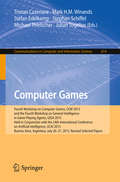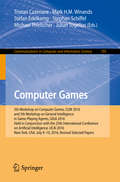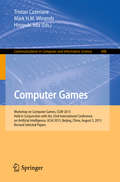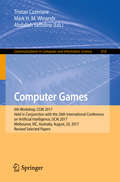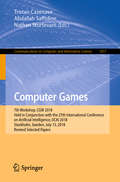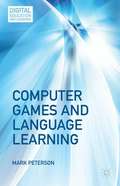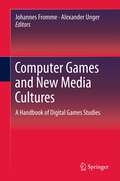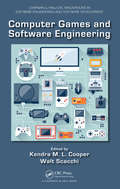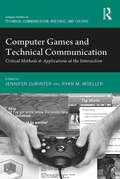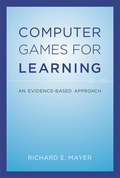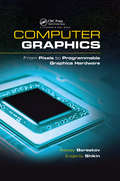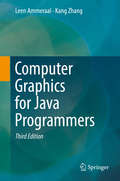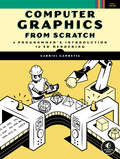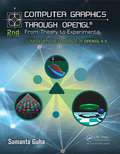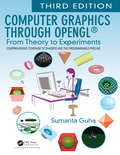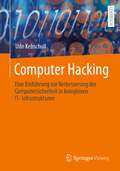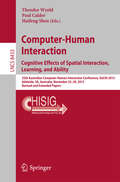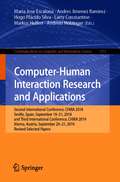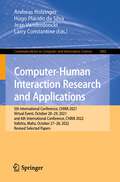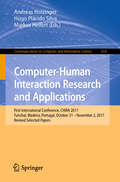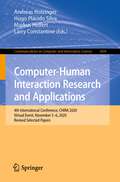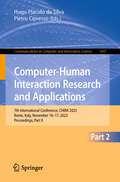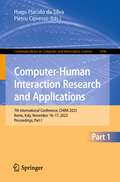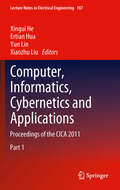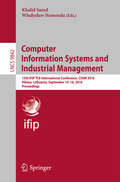- Table View
- List View
Computer Games: Fourth Workshop on Computer Games, CGW 2015, and the Fourth Workshop on General Intelligence in Game-Playing Agents, GIGA 2015, Held in Conjunction with the 24th International Conference on Artificial Intelligence, IJCAI 2015, Buenos Aires, Argentina, July 26-27, 2015, Revised Selected Papers (Communications in Computer and Information Science #614)
by Tristan Cazenave Mark H.M. Winands Stefan Edelkamp Stephan Schiffel Michael Thielscher Julian TogeliusThis book constitutes the refereed proceedings of the Fourth Computer Games Workshop, CGW 2015, and the Fourth Workshop on General Intelligence in Game-Playing Agents, GIGA 2015, held in conjunction with the 24th International Conference on Artificial Intelligence, IJCAI 2015, Buenos Aires, Argentina, in July 2015. The 12 revised full papers presented were carefully reviewed and selected from 27 submissions. The papers address all aspects of artificial intelligence and computer game playing. They discuss topics such as Monte-Carlo methods; heuristic search; board games; card games; video games; perfect and imperfect information games; puzzles and single player games; multi-player games; combinatorial game theory; applications; computational creativity; computational game theory; evaluation and analysis; game design; knowledge representation; machine learning; multi-agent systems; opponent modeling; planning; reasoning; search.
Computer Games: 5th Workshop on Computer Games, CGW 2016, and 5th Workshop on General Intelligence in Game-Playing Agents, GIGA 2016, Held in Conjunction with the 25th International Conference on Artificial Intelligence, IJCAI 2016, New York, USA, July 9-10, 2016, Revised Selected Papers (Communications in Computer and Information Science #705)
by Tristan Cazenave Mark H.M. Winands Stefan Edelkamp Stephan Schiffel Michael Thielscher Julian TogeliusThis book contains the papers of the 6th Computers and Games Conference (CG 2008)held in Beijing, China. The conference took place from September 29 th to October 1, 2008 in conjunction with the 13 International Computer Games th Championship and the 16 World Computer Chess Championship. The Computers and Games conference series is a major international forum for researchers and developers interested in all aspects of arti?cial intelligence and computer game playing. The Beijing conference was de?nitively charact- ized by fresh ideas for a large variety of games. Earlier conferences took place in Tsukuba, Japan (1998), Hamamatsu, Japan (2000), Edmonton, Canada, (2002), Ramat-Gan, Israel (2004), and Turin, Italy (2006). The Programme Committee (PC) received 40 submissions. Each paper was initiallysenttoatleasttworeferees. Ifcon?ictingviewsonapaperwerereported, itwassenttoanadditionalreferee. Outofthe40submissions, onewaswithdrawn before the ?nal decisions weremade. With the help of many referees (listed after the preface), the PC accepted 24 papers for presentation at the conference and publication in these proceedings. Theabove-mentionedsetof24paperscoversawiderangeofcomputergames. Twelve of the games are played in practice by human players, viz. , Go, We- ern Chess, Chinese Chess (Xiangqi), Japanese Chess (Shogi), Amazons, Chinese Checkers, Hearts, Hex, Lines of Action, Othello, Siguo, and Spades. Moreover, there was onepuzzle, viz. , SameGame, andtwo theoreticalgames, viz. , Synch- nized Domineering and multi-player Can t Stop. Thepapersdealwithmanydi?erentresearchtopicsincludingcognition, c- binatorial game theory, search, knowledge representation, and optimization. We hope that the readerswill enjoy the researche?orts of the authors. Below we provide a brief outline of the 24 contributions, in the order in which they are printed in the book
Computer Games: Workshop on Computer Games, CGW 2013, Held in Conjunction with the 23rd International Conference on Artificial Intelligence, IJCAI 2013, Beijing, China, August 3, 2013, Revised Selected Papers (Communications in Computer and Information Science #408)
by Tristan Cazenave Mark H.M. Winands Hiroyuki IidaThis book constitutes the refereed proceedings of the Computer Games Workshop, CGW 2013, held in Beijing, China, in August 2013, in conjunction with the Twenty-third International Conference on Artificial Intelligence, IJCAI 2013. The 9 revised full papers presented were carefully reviewed and selected from 15 submissions. The papers cover a wide range of topics related to computer games. They discuss six games that are played by humans in practice: Chess, Domineering, Chinese Checkers, Go, Goofspiel, and Tzaar. Moreover, there are papers about the Sliding Tile Puzzle, an application, namely, Cooperative Path-Finding Problems, and on general game playing.
Computer Games
by Tristan Cazenave Abdallah Saffidine Mark H.M. WinandsThis book constitutes revised selected papers from the 6th Workshop on Computer Games, CGW 2017, held in conjunction with the 26th International Conference on Artificial Intelligence, IJCAI 2017, in Melbourne, Australia, in August 2017. The 12 full papers presented in this volume were carefully reviewed and selected from 18 submissions. They cover a wide range of topics related to computer games; discussing six abstract games: Chinese Checkers, Chinese Dark Chess, Hex, Othello, Poker, and SameGame.
Computer Games: 7th Workshop, CGW 2018, Held in Conjunction with the 27th International Conference on Artificial Intelligence, IJCAI 2018, Stockholm, Sweden, July 13, 2018, Revised Selected Papers (Communications in Computer and Information Science #1017)
by Tristan Cazenave Abdallah Saffidine Nathan SturtevantThis book constitutes revised selected papers from the 7th Workshop on Computer Games, CGW 2018, held in conjunction with the 27th International Conference on Artificial Intelligence, IJCAI 2018 in Stockholm, Sweden, in July 2018.The 8 full papers presented in this volume were carefully reviewed and selected from 15 submissions. They cover a wide range of topics related to video games; general game playing.- machine learning and Monte Carlo tree search.
Computer Games And Language Learning
by Mark PetersonA comprehensive and accessible overview for language educators, researchers, and students, this book examines the relationship between technological innovation and development in the field of computer-assisted language learning, exploring relevant theories and providing practical evidence about the use of computer games in language learning.
Computer Games and New Media Cultures: A Handbook of Digital Games Studies
by Alexander Unger Johannes FrommeDigital gaming is today a significant economic phenomenon as well as being an intrinsic part of a convergent media culture in postmodern societies. Its ubiquity, as well as the sheer volume of hours young people spend gaming, should make it ripe for urgent academic enquiry, yet the subject was a research backwater until the turn of the millennium. Even today, as tens of millions of young people spend their waking hours manipulating avatars and gaming characters on computer screens, the subject is still treated with scepticism in some academic circles. This handbook aims to reflect the relevance and value of studying digital games, now the subject of a growing number of studies, surveys, conferences and publications. As an overview of the current state of research into digital gaming, the 42 papers included in this handbook focus on the social and cultural relevance of gaming. In doing so, they provide an alternative perspective to one-dimensional studies of gaming, whose agendas do not include cultural factors. The contributions, which range from theoretical approaches to empirical studies, cover various topics including analyses of games themselves, the player-game interaction, and the social context of gaming. In addition, the educational aspects of games and gaming are treated in a discrete section. With material on non-commercial gaming trends such as 'modding', and a multinational group of authors from eleven nations, the handbook is a vital publication demonstrating that new media cultures are far more complex and diverse than commonly assumed in a debate dominated by concerns over violent content.
Computer Games and Software Engineering (Chapman & Hall/CRC Innovations in Software Engineering and Software Development Series)
by Kendra M. L. Cooper Walt ScacchiComputer games represent a significant software application domain for innovative research in software engineering techniques and technologies. Game developers, whether focusing on entertainment-market opportunities or game-based applications in non-entertainment domains, thus share a common interest with software engineers and developers on how to
Computer Games and Technical Communication: Critical Methods and Applications at the Intersection (Routledge Studies in Technical Communication, Rhetoric, and Culture)
by Jennifer deWinter Ryan M. MoellerTaking as its point of departure the fundamental observation that games are both technical and symbolic, this collection investigates the multiple intersections between the study of computer games and the discipline of technical and professional writing. Divided into five parts, Computer Games and Technical Communication engages with questions related to workplace communities and gamic simulations; industry documentation; manuals, gameplay, and ethics; training, testing, and number crunching; and the work of games and gamifying work. In that computer games rely on a complex combination of written, verbal, visual, algorithmic, audio, and kinesthetic means to convey information, technical and professional writing scholars are uniquely poised to investigate the intersection between the technical and symbolic aspects of the computer game complex. The contributors to this volume bring to bear the analytic tools of the field to interpret the roles of communication, production, and consumption in this increasingly ubiquitous technical and symbolic medium.
Computer Games for Learning: An Evidence-Based Approach (The\mit Press Ser.)
by Richard E. MayerA comprehensive and up-to-date investigation of what research shows about the educational value of computer games for learning. Many strong claims are made for the educational value of computer games, but there is a need for systematic examination of the research evidence that might support such claims. This book fills that need by providing, a comprehensive and up-to-date investigation of what research shows about learning with computer games. Computer Games for Learning describes three genres of game research: the value-added approach, which compares the learning outcomes of students who learn with a base version of a game to those of students who learn with the base version plus an additional feature; the cognitive consequences approach, which compares learning outcomes of students who play an off-the-shelf computer game for extended periods to those of students who do not; and the media comparative approach, which compares the learning outcomes of students who learn material by playing a game to those of students who learn the same material using conventional media. After introductory chapters that describe the rationale and goals of learning game research as well as the relevance of cognitive science to learning with games, the book offers examples of research in all three genres conducted by the author and his colleagues at the University of California, Santa Barbara; meta-analyses of published research; and suggestions for future research in the field. The book is essential reading for researchers and students of educational games, instructional designers, learning-game developers, and anyone who wants to know what the research has to say about the educational effectiveness of computer games.
Computer Graphics: From Pixels to Programmable Graphics Hardware (Chapman And Hall/crc Computer Graphics, Geometric Modeling, And Animation Ser. #3)
by Alexey Boreskov Evgeniy ShikinComplete Coverage of the Current Practice of Computer GraphicsComputer Graphics: From Pixels to Programmable Graphics Hardware explores all major areas of modern computer graphics, starting from basic mathematics and algorithms and concluding with OpenGL and real-time graphics. It gives students a firm foundation in today's high-performance graphic
Computer Graphics for Java Programmers
by Leen Ammeraal Kang ZhangThis third edition covers fundamental concepts in creating and manipulating 2D and 3D graphical objects, including topics from classic graphics algorithms to color and shading models. It maintains the style of the two previous editions, teaching each graphics topic in a sequence of concepts, mathematics, algorithms, optimization techniques, and Java coding. Completely revised and updated according to years of classroom teaching, the third edition of this highly popular textbook contains a large number of ready-to-run Java programs and an algorithm animation and demonstration open-source software also in Java. It includes exercises and examples making it ideal for classroom use or self-study, and provides a perfect foundation for programming computer graphics using Java. Undergraduate and graduate students majoring specifically in computer science, computer engineering, electronic engineering, information systems, and related disciplines will use this textbook for their courses. Professionals and industrial practitioners who wish to learn and explore basic computer graphics techniques will also find this book a valuable resource.
Computer Graphics from Scratch: A Programmer's Introduction to 3D Rendering
by Gabriel GambettaComputer Graphics from Scratch demystifies the algorithms used in modern graphics software and guides beginners through building photorealistic 3D renders.Computer graphics are at work everywhere today, adding eye-popping details to video games, hyper-realistic CGI to major blockbusters, and life-like imagery to computer-animated films. This beginners book will introduce you to a core slice of this ever-expanding field, 3D rendering, with a focus on two popular algorithmic methods: raytracing and rasterization. Written to be easily understood by high-school students but rigorous enough for professional engineers, you&’ll build each of these surprisingly simple algorithms into complete, fully functional renderers as you build your knowledge base. The first half covers raytracing, which simulates rays of light as they bounce off of objects in a scene; the second half breaks down rasterization, the real-time process for converting 3D graphics into a screen-compatible array of 2D pixels. Every chapter gives you something visually new and exciting to add to your works-in-progress, from creating reflections and shadows that make objects look more realistic, to rendering a scene from any directional point of view. You&’ll learn how to: • Represent objects in a scene, and use perspective projection to draw them in • Compute the illumination for light sources (point, directional, and ambient) • Render mirror-like reflections on surfaces, and cast shadows for depth • Use clipping algorithms to render a scene from any camera position • Implement flat shading, Gouraud shading, and Phong shading algorithms • "Paint&” textures that fake surface details and turn shapes into everyday objects The book uses informal pseudocode throughout the text, so you can write your renderers in any language. In addition, the author provides links to live working versions of his algorithms.
Computer Graphics Through OpenGL: From Theory to Experiments
by Sumanta GuhaFrom geometric primitives to animation to 3D modeling to lighting, shading, and texturing, Computer Graphics Through OpenGL: From Theory to Experiments, Second Edition presents a comprehensive introduction to computer graphics that uses an active learning style to teach key concepts. Equally emphasizing theory and practice, the book provides an und
Computer Graphics Through OpenGL®: From Theory to Experiments
by Sumanta GuhaCOMPREHENSIVE COVERAGE OF SHADERS AND THE PROGRAMMABLE PIPELINE <P><P> From geometric primitives to animation to 3D modeling to lighting, shading and texturing, Computer Graphics Through OpenGL®: From Theory to Experiments is a comprehensive introduction to computer graphics which uses an active learning style to teach key concepts. Equally emphasizing theory and practice, the book provides an understanding not only of the principles of 3D computer graphics, but also the use of the OpenGL® Application Programming Interface (API) to code 3D scenes and animation, including games and movies. The undergraduate core of the book takes the student from zero knowledge of computer graphics to a mastery of the fundamental concepts with the ability to code applications using fourth-generation OpenGL®. The remaining chapters explore more advanced topics, including the structure of curves and surfaces, applications of projective spaces and transformations and the implementation of graphics pipelines. This book can be used for introductory undergraduate computer graphics courses over one to two semesters. The careful exposition style attempting to explain each concept in the simplest terms possible should appeal to the self-study student as well. <P><P> Features <br>• Covers the foundations of 3D computer graphics, including animation, visual techniques and 3D modeling• Comprehensive coverage of OpenGL® 4.x, including the GLSL and vertex, fragment, tessellation and geometry shaders• Includes 180 programs with 270 experiments based on them• Contains 750 exercises, 110 worked examples, and 700 four-color illustrations• Requires no previous knowledge of computer graphics• Balances theory with programming practice using a hands-on interactive approach to explain the underlying concepts
Computer Hacking: Eine Einführung zur Verbesserung der Computersicherheit in komplexen IT-Infrastrukturen
by Udo KebschullTechnische Maßnahmen, die es Cyberangreifern schwer machen, dienen zur Abschreckung, weil Hacker immer nur so hoch springen, wie sie müssen. Bei komplexen und vor allem sicherheitsrelevanten IT-Infrastrukturen reichen diese technischen Maßnahmen allein jedoch oft nicht aus.Dieses Lehrbuch betrachtet alle Aspekte der IT-Sicherheit und effektive Maßnahmen, um Angriffe zu detektieren und sich erfolgreich dagegen zu wehren. Es behandelt allgemeine Angriffsmechanismen und Angriffsszenarien, die von Angreifern angewendet werden. Dabei soll klar werden, dass es nicht ausreichend ist, Firewall-Regeln sauber zu konfigurieren oder die aktuellsten Patches einzuspielen. Vielmehr muss ein ganzheitlicher Ansatz gewählt werden, der Nutzende einschließt (Awareness) und funktionierende Prozesse für den Fall eines konkreten Angriffs etabliert. Das Buch zeigt, wo die Schwachstellen liegen, wie man sie schließt, wie man Angriffe erkennt und wie man sie erfolgreich abwehrt.
Computer-Human Interaction. Cognitive Effects of Spatial Interaction, Learning, and Ability: 25th Australian Computer-Human Interaction Conference, OzCHI 2013, Adelaide, SA, Australia, November 25-29, 2013. Revised and Extended Papers (Lecture Notes in Computer Science #8433)
by Theodor Wyeld Paul Calder Haifeng ShenThis book constitutes the thoroughly refereed post-conference proceedings of the 25th Australian Conference on Computer-Human Interaction, OzCHI 2013, held in Adelaide, SA, Australia, in November 2013. The 11 revised extended papers were carefully reviewed and selected from 192 submissions and cover topics on multi-dimensional interaction; video gaming; spatial learning; and physical spatial interaction.
Computer-Human Interaction Research and Applications: Second International Conference, CHIRA 2018, Seville, Spain, September 19-21, 2018 and Third International Conference, CHIRA 2019, Vienna, Austria, September 20-21, 2019, Revised Selected Papers (Communications in Computer and Information Science #1351)
by Maria Jose Escalona Andres Jimenez Ramirez Hugo Plácido Silva Larry Constantine Markus Helfert Andreas HolzingerThis book constitutes selected papers of the Second International Conference on Computer-Human Interaction Research and Applications, CHIRA 2018, held in Seville, Spain, in September 2018, and Third International Conference on Computer-Human Interaction Research and Applications, CHIRA 2019, held in Vienna, Austria, in September 2019.The 7 full papers presented in this book were carefully reviewed and selected from 28 submissions for CHIRA 2018 and 36 submissions for CHIRA 2019. The papers selected to be included in this book contribute to the understanding of relevant trends of current research on computer-human interaction, including Interaction design, human factors, entertainment, cognition, perception, user-friendly software and systems, pervasive technologies and interactive devices.
Computer-Human Interaction Research and Applications: 5th International Conference, CHIRA 2021, Virtual Event, October 28–29, 2021, and 6th International Conference, CHIRA 2022, Valletta, Malta, October 27–28, 2022, Revised Selected Papers (Communications in Computer and Information Science #1882)
by Andreas Holzinger Hugo Plácido da Silva Jean Vanderdonckt Larry ConstantineThis post-conference book constitutes selected papers of the Fifth International Conference on Computer-Human Interaction Research and Applications, CHIRA 2021, held virtually due to COVID 19, and Sixth International Conference on Computer-Human Interaction Research and Applications, CHIRA 2022, held in Valletta, Malta, in October 2022.The 8 full papers presented in this book were carefully reviewed and selected from 48 submissions for CHIRA 2021 and 37 submissions for CHIRA 2022. The papers selected to be included in this book contribute to the understanding of relevant trends of current research on computer-human interaction, including user-centered interaction design patterns, user experience design, multimedia and multimodal Interaction, interaction design modelling, haptic and tangible devices, accessible and adaptive interaction, user behaviour analysis, user experience evaluation, modelling human factors, mobile computer-human interaction, machine learning, information retrieval, human-centered AI and design and evaluation.
Computer-Human Interaction Research and Applications: First International Conference, CHIRA 2017, Funchal, Madeira, Portugal, October 31 – November 2, 2017, Revised Selected Papers (Communications in Computer and Information Science #654)
by Andreas Holzinger Hugo Plácido Silva Markus HelfertThis book constitutes the refereed proceedings of the First International Conference on Computer-Human Interaction Research and Applications, CHIRA 2017, held in Funchal, Madeira, Portugal, in October/November 2017.The 8 full papers presented in this book were carefully reviewed and selected from 35 submissions. The papers selected to be included in this book contribute to the understanding of relevant trends of current research on computer-human interaction, including Interaction design, human factors, entertainment, cognition, perception, user-friendly software and systems, pervasive technologies and interactive devices.
Computer-Human Interaction Research and Applications: 4th International Conference, CHIRA 2020, Virtual Event, November 5–6, 2020, Revised Selected Papers (Communications in Computer and Information Science #1609)
by Andreas Holzinger Hugo Plácido Silva Markus Helfert Larry ConstantineThis book constitutes selected papers of the Fourth International Conference on Computer-Human Interaction Research and Applications, CHIRA 2020, held virtually, in November 2020.The 8 full papers presented in this book were carefully reviewed and selected from 44 submissions. The papers selected to be included in this book contribute to the understanding of relevant trends of current research on computer-human interaction, including Interaction design, human factors, entertainment, cognition, perception, user-friendly software and systems, pervasive technologies and interactive devices.
Computer-Human Interaction Research and Applications: 7th International Conference, CHIRA 2023, Rome, Italy, November 16–17, 2023, Proceedings, Part II (Communications in Computer and Information Science #1997)
by Hugo Plácido da Silva Pietro CipressoThese 2 volumes constitute the selected papers of the 7th International Conference, CHIRA 2023, held Rome, Italy, during November 16–17, 2023.The 14 full papers and the 29 short papers presented in these books were carefully reviewed and selected from 69 submissions. The papers selected contribute to the advancement of research and practical applications of human-technology and human-computer interaction. Different aspects of Computer-Human Interaction were covered in four parallel tracks: human factors for interactive systems, research, and applications; interactive devices; interaction design; and adaptive and intelligent systems.
Computer-Human Interaction Research and Applications: 7th International Conference, CHIRA 2023, Rome, Italy, November 16–17, 2023, Proceedings, Part I (Communications in Computer and Information Science #1996)
by Hugo Plácido da Silva Pietro CipressoThese 2 volumes constitute the selected papers of the 7th International Conference, CHIRA 2023, held Rome, Italy, during November 16–17, 2023.The 14 full papers and the 29 short papers presented in these books were carefully reviewed and selected from 69 submissions. The papers selected contribute to the advancement of research and practical applications of human-technology and human-computer interaction. Different aspects of Computer-Human Interaction were covered in four parallel tracks: human factors for interactive systems, research, and applications; interactive devices; interaction design; and adaptive and intelligent systems.
Computer, Informatics, Cybernetics and Applications: Proceedings of the CICA 2011 (Lecture Notes in Electrical Engineering #107)
by Xiaozhu Liu Ertian Hua Xingui He Yun LinThe Conference on Computer, Informatics, Cybernetics and Applications 2011 aims to facilitate an exchange of information on best practices for the latest research advances in the area of computer, informatics, cybernetics and applications, which mainly includes computer science and engineering, informatics, cybernetics, control systems, communication and network systems, technologies and applications, others and emerging new topics.
Computer Information Systems and Industrial Management: 15th IFIP TC8 International Conference, CISIM 2016, Vilnius, Lithuania, September 14-16, 2016, Proceedings (Lecture Notes in Computer Science #9842)
by Władysław Homenda Khalid SaeedThis book constitutes the refereed proceedings of the 11th International Conference on Computer Information Systems and Industrial Management, CISIM 2012, held in Venice, Italy, in September 2012. The 35 revised full papers presented together with 2 keynote talks were carefully reviewed and selected from 80 submissions. The papers are organized in topical sections on security, access control and intrusion detection; pattern recognition and image processing; biometric applications; algorithms and data management; networking; and system models and risk assessment.
